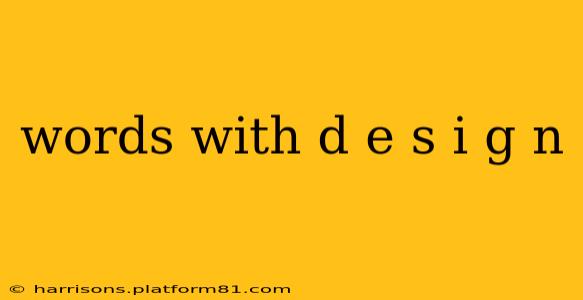Words with Design: Exploring the Nuances of a Powerful Term
The word "design" carries immense weight, encompassing far more than just aesthetics. It speaks to the process of conceiving and planning the creation of something, be it a building, a website, a marketing campaign, or even a social interaction. This exploration dives into the multifaceted nature of "design," examining its various connotations and related words.
What are some synonyms for design?
This question gets to the heart of the word's flexibility. There isn't one perfect synonym, as the best choice depends heavily on context. However, here are several options and when they might be appropriate:
- Plan: This emphasizes the strategic and pre-emptive nature of design. Think architectural blueprints or a meticulously crafted business strategy.
- Scheme: Suggests a more intricate or potentially deceptive plan, often used in contexts like a marketing scheme or a villain's evil scheme.
- Draft: Highlights the preliminary, often imperfect, stage of the design process. It's a working version subject to revision.
- Blueprint: Specifically refers to a detailed technical drawing, particularly in architecture or engineering.
- Layout: Focuses on the arrangement and organization of elements within a design, often used in graphic design or page layout.
- Style: While related, style is more about the aesthetic choices within a design, while design encompasses the entire process and concept.
What are some words related to design thinking?
"Design thinking" is a human-centered approach to problem-solving. Words associated with this process often emphasize creativity, innovation, and user-centricity:
- Innovation: The process of creating something new or improved. Design thinking is a crucial driver of innovation.
- Creativity: The ability to generate novel and valuable ideas; a core component of design thinking.
- Iteration: The cyclical process of refinement; design thinking relies heavily on iterative prototyping and testing.
- Prototyping: Creating a preliminary version of a design to test and gather feedback.
- Empathy: Understanding and sharing the feelings of others; crucial in user-centered design.
- Experimentation: Trying different approaches to find the best solution; an integral part of the design process.
What are different types of design?
The field of design is incredibly broad. Here are a few key areas:
- Graphic Design: Focuses on visual communication, using typography, imagery, and other elements to convey messages.
- Web Design: Creating user-friendly and visually appealing websites.
- Interior Design: Planning and designing the interior spaces of buildings.
- Industrial Design: Designing manufactured products, focusing on functionality, aesthetics, and ergonomics.
- Fashion Design: Creating clothing and accessories.
- Game Design: Creating the rules, mechanics, and overall experience of video games.
- UX/UI Design: Focusing on the user experience and user interface of digital products.
How does design impact our lives?
Design is ubiquitous, subtly yet profoundly shaping our experiences:
- Functionality: Good design makes products and services easier to use and more efficient.
- Aesthetics: Design impacts how we perceive and interact with the world around us, influencing our emotions and experiences.
- Accessibility: Inclusive design ensures that products and services are usable by people of all abilities.
- Sustainability: Design can play a significant role in creating environmentally friendly and sustainable solutions.
- Innovation: Design drives innovation by creating new and improved products and services.
By understanding the breadth and depth of the word "design" and its related concepts, we can better appreciate its crucial role in shaping our world. From the mundane to the extraordinary, design permeates every aspect of our lives, influencing how we interact with the world and the things in it.
